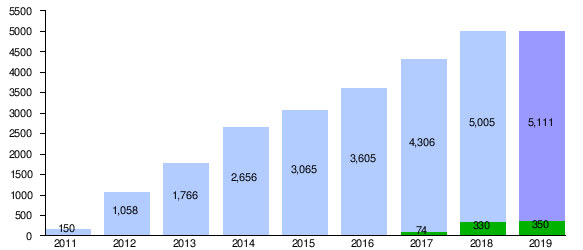Three companies’ earnings calls are included: Tilray, Inc. (TLRY), Canopy Growth Corporation (CGC), Aurora Cannabis Inc. (ACB).
Cronos Group Inc. (CRON) is expected to release 18Q4 earnings next week.
It is a newly opened (legalized) industry that has already attracted some big names’ attention. Its recreational uses, plus its potentials in medical settings and beverages, are supporting some huge market estimates and (partially) their sky-high valuations.

Net Revenue and yoy growth for the quarter ended on December 31, 2018
CGC – $83 million / 282%
ACB – $54 million / 363%
TLRY – $15.5 million / 204% (revenue includes excise tax of ~$2 million, so $13.5 million net)
[Update 3/26] CRON – $5.6 million / 248%
As the revenue multiple is incredibly high, companies need to ramp up its revenue very fast (to catch up with capital market’s expectations). As the actual cannabis markets usually need more time to educate/develop/open up, it is extremely important to rely on top-tier partners (and their distribution networks) to expand globally to keep the 200%+ growth.
So starting with a roundup of…
Industry Collaborations (where/how to sell)
January 15, 2019: TLRY + Authentic Brands Group – $350 million payments to ABG and revenue sharing of 49%
-
- TLRY as a supplier and sharing revenue from its white-labeled products; ABG as a brand manager and distributer
- the parties will leverage ABG’s portfolio of brands to develop, market and distribute consumer cannabis products across the world, with an immediate focus on [CBD] opportunities in Canada and US
- TLRY will initially pay to ABG US$100 million and up to US$250 million in cash and stock, subject to the achievement of certain commercial and/or regulatory milestones
- TLRY will have the right to receive up to 49% of the net revenue from cannabis products bearing ABG brands, with a guaranteed minimum payment of up to US$10 million annually for 10 years, subject to certain commercial and/or regulatory milestones.
- TLRY will be the preferred supplier of active cannabinoid ingredients for such products
- ABG has a global retail footprint of over 100,000 points of sale and more than 4,500 branded freestanding stores and shop-in-shops
December 19, 2018: TLRY + AB InBev – up to $100 million JV in non-alcohol cannabis beverages
-
- the partnership is limited to Canada for now;
- AB InBev’s participation will be through its subsidiary Labatt Breweries of Canada (up to $50 million);
- Tilray’s participation will be through its Canadian adult-use cannabis subsidiary High Park Company (up to $50 million)
December 18, 2018: TLRY + Novartis (Sandoz) – medical cannabis
-
- this is a global version of a previously signed agreement focused in Canada;
- the merit of the agreement is about supply (TLRY) & distribute (Sandoz) in the healthcare industry;
- don’t think the margin would be high for TLRY; but if they develop new co-branded cannabis products, could be interesting
December 7, 2018: CRON + Altria – USD $1.8 Billion (CAD $2.4 Billion) investment
-
- the deal gives Altria a 45% equity stake in CRON and an additional 10% ownership interest through warrants if exercised in full;
- shares are purchased @C$16.25/shr;
- warrants are issued at an exercise price of C$19.00/shr, exercisable over four years from the closing date
- Altria will have the right to nominate 4 directors, including 1 independent director, expanding CRON’s Board of Directors from 5 to 7
August 15, 2018: CGC + Constellation Brands – $5 billion CAD ($4 billion USD) investment and beverages
-
- the agreement is the largest deal in this space and is a significant equity investment, after which Constellation Brands will increase its ownership in CGC to ~38%, including existing ownership (9.9% in October 2017) and warrants
- shares are purchased @ C$48.60/shr, a 51.2% premium to the previous closing price
- new warrants are issued @ C$50.40/shr; if all exercised (existing and new), its ownership would exceed 50 percent
-

Constellation Brands’ ownership in CGC | Source: CGC Investor Presentation - Constellation will nominate 4 directors to Canopy Growth’s 7-member Board of Directors
- A detailed presentation
September 17, 2018: Rumor but no agreement: ACB + Coca-Cola
-
- Sep-18: Aurora said there is no agreement: “The Company does confirm that it engages in exploratory discussions with industry participants from time to time,” Aurora said in a press release.”
- Sep-18, Coke’s statement following the report: “We have no interest in marijuana or cannabis. Along with many others in the beverage industry, we are closely watching the growth of non-psychoactive CBD as an ingredient in functional wellness beverages around the world. The space is evolving quickly. No decisions have been made at this time.”
March 13, 2019: ACB got a strategic advisor Nelson Peltz
-
- he could bring some industry collaborations/investments that others had done, while granted options to purchase ~20 million ACB shares
- Mr. Peltz (through Trian) held large positions or had board seats on many companies such as PepsiCo, Dr Pepper Snapple, Procter & Gamble, Kraft Foods, Heinz, Mondelez




 Making users as their marketing tools sounds a brilliant idea and is indeed very unique to Tencent. No one else could help to build such a big enterprise within a short period of time. (Alibaba has similarly powerful app such as Alipay but not social – can’t make users part of its marketing)
Making users as their marketing tools sounds a brilliant idea and is indeed very unique to Tencent. No one else could help to build such a big enterprise within a short period of time. (Alibaba has similarly powerful app such as Alipay but not social – can’t make users part of its marketing)










